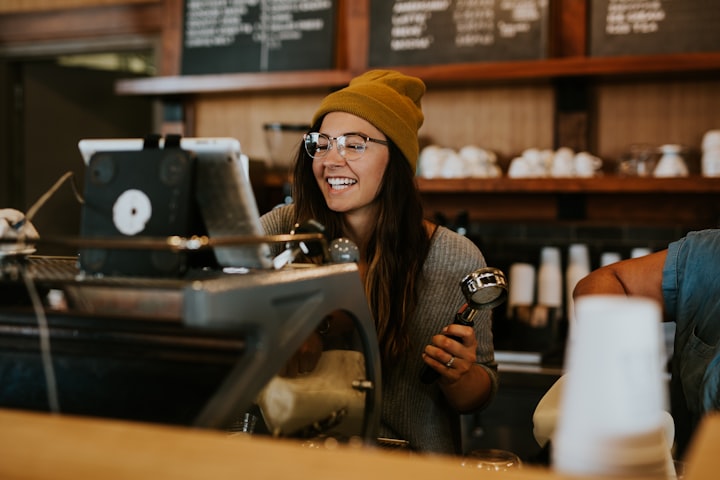Seattle; the birthplace of Boeing, the giants of software, grunge music and ... signature coffee. Very good, not pretty. Contrary to popular belief, while Pearl Jam, Nirvana, Boeing, and Oracle no doubt hail from the Pacific Northwest, the modern signature espresso has its roots much further south.
When Alfred Peet died in his sleep a few months ago, he was a sprightly 87 years old. He passed away peacefully, with any luck, dreaming of espresso trees strewn with ripe cherries. While many people didn't listen to him, Pete is widely credited as the father of the sector's recent "special coffee". He was a Dutchman who grew up to be an American. He sold tea at Lipton's in Java, lived in Sumatra, worked for an organization in New Zealand right before finally settling (largely) in the university suburb of Berkeley, California. It was in Berkeley, where he established his roastery in 1966, that Peet's Coffee was born. Alfred Piet was delighted with the espresso. His exploits in roasting are legendary, and his ability to commentate, roast and put out fires at the same time is well known. His activities, despite living in Indonesia, defined his closeness to the farmers who grew espresso, as well as his in-depth familiarity with the origins in which espresso was developed. This track record, combined with his love of roasting, resulted in coffee being not only a cup of Java, but something exotic, living and using history.
Alfred Peet's inspirational example spawned the many espresso cultures that are now household names in the US and around the world, and Starbucks obviously remains the best known of them all. The original founders of Starbucks Baldwin, Bowker and Ziv Seigel initially relied on their roasting from Pete, in fact Pete roasted for them in their early years. Several other people working in the US these days also died due to the Peet's Espresso experience. The truth is that when Howard Schultz ordered Starbucks, Bowker and Baldwin moved in and bought Peets Coffee - Alfred Peet retired, becoming part of Espresso Mentor to the Field as one.
Today, most espresso drinkers, from Surabaya to San Francisco, recognize Starbucks and its symbol, even though the name "Alfred Peet" usually grabs attention.
Right now, Specialty Espresso is at a crossroads - a major crossroads in the espresso course that will dominate the next 10 years. Over the past ten decades, many newcomers have come to the enterprise. It can be assumed that the international espresso sector is now valued at around US$80 billion. Unsurprisingly, by leveraging these profit margins, the sector is attracting business men and women with a mixed agenda, who usually see potential baselines, rather than education, training and passion, as the driving force behind everything they do. Traditionally, the specialty espresso market has been built on a strong foundation of knowledge and experience sharing, with the assumption that by helping each other, the market can be strongly quality oriented. However, many of the larger current newcomers to the sector are likely choosing coffee for perceived easy profits rather than actual enthusiasm for coffee or its heritage. As a result, many of the conventional methods of trading are usually not as productive or used as often as they are out of the past.
Around the world, espresso is in a situation where consumption is starting to slow down and the prospects for espresso development have become more difficult to find in the classic espresso consuming markets of Europe, USA, South America and Oceania. The easy answer, if you look at the new emerging markets - China, India, Pakistan and Indonesia are the main targets. These countries around the world either consume little coffee (e.g. Indonesians consume 500g per person per calendar year compared to Norway's 12kg per person per year) or have fair consumption but are historical tea buyers (India) . . New markets are also highly receptive to Western branding—in many scenarios, the power of branding has proven to be more significant than that of the product itself. This gives quite a lot of options for strong Western brands and of course for new nearby manufacturers to emerge. But even so, this does not mean the longevity of branded espresso in these new conditions.

In other experienced markets, consumption styles have changed markedly over the last 15-20 years. Traditional low-quality coffee products such as instant coffee are being replaced by roasted and floor coffee (drops, plungers, etc.), not to mention espresso-based drinks (cappuccino, latte, espresso, etc.). Refreshing roasted espresso has several strengths. It's very tasty and, more importantly, has a great reference to the place it was originally sourced from. Thus, customer awareness is also growing, highlighting the actual documentary trail of where espresso comes from, who harvested it, what value the producer derives from it, and so on. For people in countries such as New Zealand, this is certainly very important, as there is usually a link between high quality coffee and the profit that the farmer or producer will receive. The correlation is definitely such that the higher the income for some farmers, the higher the coffee will be. Greater yields usually mean that extra time can be spent in the country of origin needed immediately after harvesting, trimming, selective harvesting, good intensive drying and packaging/storage of the espresso after it has really dried.
The role of specialty coffee in all this is incredibly important. Retailers that source and provide only the most efficient coffee are helping to keep the industry going both upstream and downstream. This suggests that farmers and staff will be rewarded and customers will likely have access to quality espresso, ideally further expanding the business venture.
Unfortunately, the opposite is slowly becoming the norm. Cafes, espresso shops and roasters growing in the industry around the world are likely to be looking for short-term professionals to try and capitalize on their small businesses. To do this, they can buy bad quality espresso, as cheap as possible, or regular excellent coffee... also as cheap as possible. Inexpensive coffee equates to the best, incredibly typical finished product. This, in turn, means a generally poor perception of your place where espresso is served. Perhaps it would be good if there were not so many cafes now offering poor quality espresso. Be that as it may, this means that very poor quality espresso is now considered the norm, causing people to stop drinking coffee.
In several approaches, you can see that market ownership is almost in a circle, returning to the state it was in in the early 1970s, when instant coffee and occasional sitting on the stove for ten hours were considered and accepted as standard coffee. This is what pioneers like Pete have worked so hard to achieve. That is why the intersection where the field is now located is so important.
The choice is really very easy. In order for espresso to develop and develop even more, education is necessary for both your seller and the buyer. The global marketplace is built around nationwide organizations that perform various tasks of providing advice and training to those involved in the retail or wholesale trade. Two such organizations are the Special Espresso Company of the United States (SCAA) and the SCAE (Special Espresso Company of Europe). However, becoming a customer of such organizations is as simple as filling out a form and paying a fee. Usually the commitment of your people who follow you is just to get a sticker to put on their store doors, knowledge is really a secondary motivator. Of course, it is said that membership should include some form of basic entrance test after which you can continue your education via the Internet, which can at least help provide tools to communicate information to all coffee drinkers.
Studying the people in the industry who calculate the factors correctly is also a good way to create and set up the future of specialty espresso. In the US, top roasters and café operators such as Allegro, Blackstump Coffee and Intelligensia have raised industry standards to new heights. Purchasing quality espresso, hiring top-notch employees, and providing a first-class experience to customers buying their morning espresso has proven to be highly productive for these companies. So much so that it can become an undeniable part of their corporate lifestyle. All these organizations also keep an eye on something unique - they often check their manufacturers in countries such as Indonesia, Guatemala, Kenya, Brazil and Colombia. To select this particular event, they don't just visit and spend a couple of nights using images of the grower's coffee trees, they interact regularly with coffee growers. This strategy needs to be considered given that the future of espresso is in aggressive markets focused on high quality. It's really a proper marriage espresso, where the default roaster gets a cut from a large family of farmers.
Getting the word out to those who buy coffee every day, and arming them with information about what kind of coffee they drink, how it's grown, who grows it, when it's actually harvested, how it gets to them, gives all the energy. on the consumer. This is indeed a vital but lagging part of the long term development of espresso around the world. Preparing to overcome inconsistencies in cupping flavors/attributes has a somewhat snobbish quality, but more importantly, it can help the client distinguish between very good, average, and very bad espresso. This is where the challenge lies. Efficient cafe, created in accordance with the concepts of sustainable development and strict coffee traditions, does not worry about learning at all. A cafe that promotes poor quality espresso is unlikely, and may not be able to teach customers high quality.
Failure to provide good quality, instructions and sustainability in the corporate sector (farmer to retailer) will eventually lead to even more decline in usage styles. High quality issues, especially over-the-counter and over-the-counter issues need to be addressed. Otherwise, however, they will have to put up with the manufacturer or place of origin, not the seller. With a modern economy, a manufacturer in Indonesia receives only about 2-5% of the price of a regular cup sold in America or Europe. If demand from customers drops, the Arabica coffee business venture will, in the long run, fall back into the commodity pricing cycle rather than the special pricing that many premium producers now enjoy. Competition from other drinks and lifestyle choices. , to fight all the one-time cash flow from which the espresso will come.
However, if Alfred Peet were alive, he would certainly just take over what he did perfectly and loved, roasting espresso and sharing his information and experience with anyone who is passionate and eager to learn and listen - a model for all of us while we were in the market these days.
Thank you So much for you to reading till the end, and please kindly to support me as you could, I would be appreciate it. Have a great day:D
About the Creator
Eful
Hi there, I am Syaefullah Nur from Indonesia. I am reader and now I try to providing my best articles for you guys. Enjoy it;)







Comments
There are no comments for this story
Be the first to respond and start the conversation.